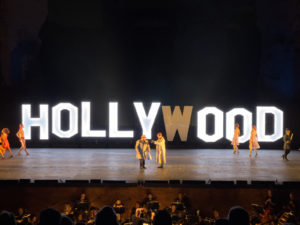- Caracalla
- Gioachino Rossini, music
- Cesare Sterbini, libretto
- Stefano Montanari, conductor
- Lorenzo Mariani, director
- Luciano Cannito, stage direction collaborator/choreographer
- Roberto Gabbiani, chorus master
- William Orlandi, set design
- Silvia Aymonino, costume designer
- Linus Fellbom, lighting designer
- Orchestra e coro del Teatro dell’opera di Roma
- Figaro: Markus Werba
- Rosina: Cecilia Molinari
- Il conte di Almaviva: René Barbera
- Don Bartolo: Marco Filippo Romano
- Don Basilio: Alex Esposito
- Berta: Francesca Benitez
- Fiorello: Davide Giangregorio
- Police Sergeant: Leo Paul Chiarot
本来是定了 8 月 2 日的首次演出,但我生病了,不得不改为之后的场次。另外之前本来要去的圣则济利亚合唱团的演出,因为我把日期记错了而报废。所以本场就是这个夏天我最后的现场演出了。此时天气已经略为凉爽,风吹起来还有点儿凉快。
演出开始之前有一个来自经理的通知,这次我的邻座是意大利人,我问了一下通知内容(大概听出来是关于 Almaviva 的歌手),他听明白了但英语不利索;但他跟我保证说演员没换。后来用望远镜看见 René Barbera 腿上打着固定,估计通知内容是演员轻伤不下火线吧。
制作再次施展了意大利人数典忘祖的艺能,把故事搬到了美国。而灯光也不遑多让,开场直接就没把灯饰 HOLLYWOOD 的 W 点亮(故障很快就排除了)。意大利含量在演出的前三分钟就爆表了。演出本身倒是令人愉快,而且结束的时间没有晚的那么离谱,搭车回家也异常顺利。

接下来就是很难为情的坦白时刻。当我看到场景里有一个大笼子,觉得这一幕非常熟悉;而演出中出现的巨型沙发和巨型钢琴也似曾相识。但我压根儿就没有意识到这就是我之前在香港看到的同一个制作!等过了好几天要写这一篇时翻看旧日志才发现。我在几篇 blog 之间已经从凡事“想当年”极速走到了失忆症。唯一值得欣慰的是对于这个制作的看法我从一而终没有改变;但表演方面确实是罗马这边自然得多。
这次我还特别留意地拍下了浴场的文字介绍。考虑到读者们的英语水平普遍在线,就不翻译了:
We are in the area of the Baths of Caracalla, one of the largest and most evocative thermal complexes of antiquity. Marcus Aurelius Antoninus Caracalla (188–217) began its construction in 212 AD in a peripheral quarter of the southern part of the city. Five years of work and 9000 workmen excavated the slopes of the Aventine hill to build this gigantic complex.
In the 5th century the Baths were considered one of the seven wonders of Rome for the grandeur of their architecture, the abundance of decorations and artwork used for their embellishment and for the number of persons they could accomodate.
The Baths were used until 537 AD, the year in which the King of the Goths, Vitige cut off the aqueducts that supplied the city. Between the 6h and in century the central part of the building was utilized as a free hospice for pilgrims and foreigners (xenodochium), while the surrounding area became a cemetery. Since then the entire area was abandoned and was used for housing and vineyards, while the architectonic section continued to be exploited as a quarry for salvaged materials.
Under the pontificate of Pope Paul III Farnese (1534–1549), in the ancient thermal area and the surrounding zone towards Circus Maximus, an excavation was carried out where many important ancient sculptures were uncovered, among them the colossal group called “Farnese Bull,” today housed in the National Archeological Museum in Naples.
At the end of the 19th century the entire area has been redeveloped, recovering the ancient street layout and creating new parks and gardens.
Since 1937 the ruins of the Baths are an evocative background for the summer season of the Teatro dell’Opera of Rome.
Between 1935 and 1939, in the area overlooking the northwestern Exedra monument of the thermal complex, the Baths of Caracalla Stadium was built, later to be named after broadcast reporter Nando Martellini in 2004.
另有一篇关于地名的介绍:
In 2011, in honor of the 90 years of activity of the Knights of Columbus in Rome (1920–2010), the area between Via Antonina and Viale delle Terme di Caracalla is named Largo Cavalieri di Colombo.
On October 2, 1881 in St. Mary’s Church in New Haven, Connecticut (USA), a young priest named Michael J. McGivney united a group of men in order to create an organization which one day would become the largest world association at the service of Catholic families.
The main principles upon which their organization was based and included in the constitution of the Knights of Columbus in March 1882 were “charity, unity, fraternity, patriotism.”
During the period of the First World War, the Knights of Columbus responded with enthusiasm to the request of providing spiritual support and recreational materials to the armed forces in service. With the motto “Everyone Welcome, Everything Free”, numerous reception camps were instituted in the major war zones in the United States and also abroad.
In 1920, Holy Father Benedict XV received the Knights with words of “encouragement and sentiments of great hope” and asked them to extend their activities to Rome. Five athletic facilities were built between 1922 and 1960 under the careful guide of the Governatorate of the Vatican City State and the Architect of the Apostolic Palaces, Count Enrico Pietro Galeazzi.
As an international organization of Catholic laity, the Order has had many opportunities to support the Roman Catholic Church in Rome and abroad.
The programs and activities of the Knights of Columbus continue their defense of the needy with vital assistance as well as supporting freedom of faith. The Order, which is present in 14 nations with more than 14,000 councils, reached, in 2011, approximately 2 million members in the world.
